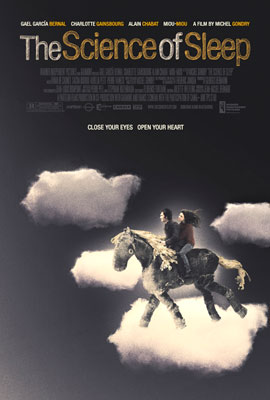Movie review: The Science of Sleep
This trippy independent film took over 15-year-old Angela’s life.

Weeks after watching The Science of Sleep, I’m still obsessed with its haunting but charming eccentricities. It’s a weird, nonsensical, enchanting movie that had me listening to its soundtrack on repeat, wearing a ski cap in SoCal and, well, dreaming.
The main character, Stephane Miroux, walks around Paris wearing a red ski cap, throwing TVs into rivers and stealing toy ponies from his neighbor. After he steals the stuffed pony, he makes it into a galloping machine with the help of a pair of pliers and some batteries. And that’s all when he’s awake. The movie fades in and out of Stephane’s dreams, as well as in and out of English, French and Spanish.
Gael Garcia Bernal plays Stephane, an inventor and artist from Mexico who comes to live in France with his mother. He meets his neighbor, Stephanie, played by Charlotte Gainsbourg, and eventually strikes up a complicated relationship with her that isn’t really a relationship but kind of is. It’s really weird—basically they never are interested in dating each other at the same time. And when they finally are, he gets too insecure to go on the date. Stuck with a dull job and this confusing relationship, Stephane turns to his dreams to escape the monotony and his insecurities about Stephanie, as he has done since he was a child.
In his dreams, he is the host of his own television show, StephaneTV, where he creates his dreams with pieces of his day, his memories, and “love, friendships, relationships, and all those ships.” From there, he goes on to dreams where he walks through rooms filled with records or builds a world with cardboard. Stephane’s dreams are very vivid, kind of creepy, but always eerily beautiful.
The movie ends with a dream of the two of them sailing away in a boat, but nothing is resolved. Stephane and Stephanie’s relationship hasn’t really changed, nor have his insecurities and dreams. At first I was unsatisfied with this ending. In fact, I was surprised by the credits, because I was still waiting for an ending. However, The Science of Sleep didn’t really need an ending. Needless to say, it’s not a movie for people who love plots.
Instead, The Science of Sleep was all the beautiful things I had ever dreamed of smashed together: huge furry creatures typing on giant typewriters, cotton-ball clouds floating in rooms, glasses that show the world in 3-D (yes, 3-D, but as Stephane says, “Come on.”). What made it even lovelier was the soundtrack. There were wistful songs whose notes floated in and out of each other, as well as jarring, noisy rock for Stephane’s more nightmarish dreams. It’s hard to describe, but it’s what dreams sound like. Check it out at http://wip.warnerbros.com/scienceofsleep/.
If you must watch logical movies that make sense, if you need a movie with a beginning, middle and end, go watch another movie. The Science of Sleep may be a confusing jumble of beautiful ideas, beautiful music and beautiful objects, but everything about it is simple. And its simplicity makes me happy.

